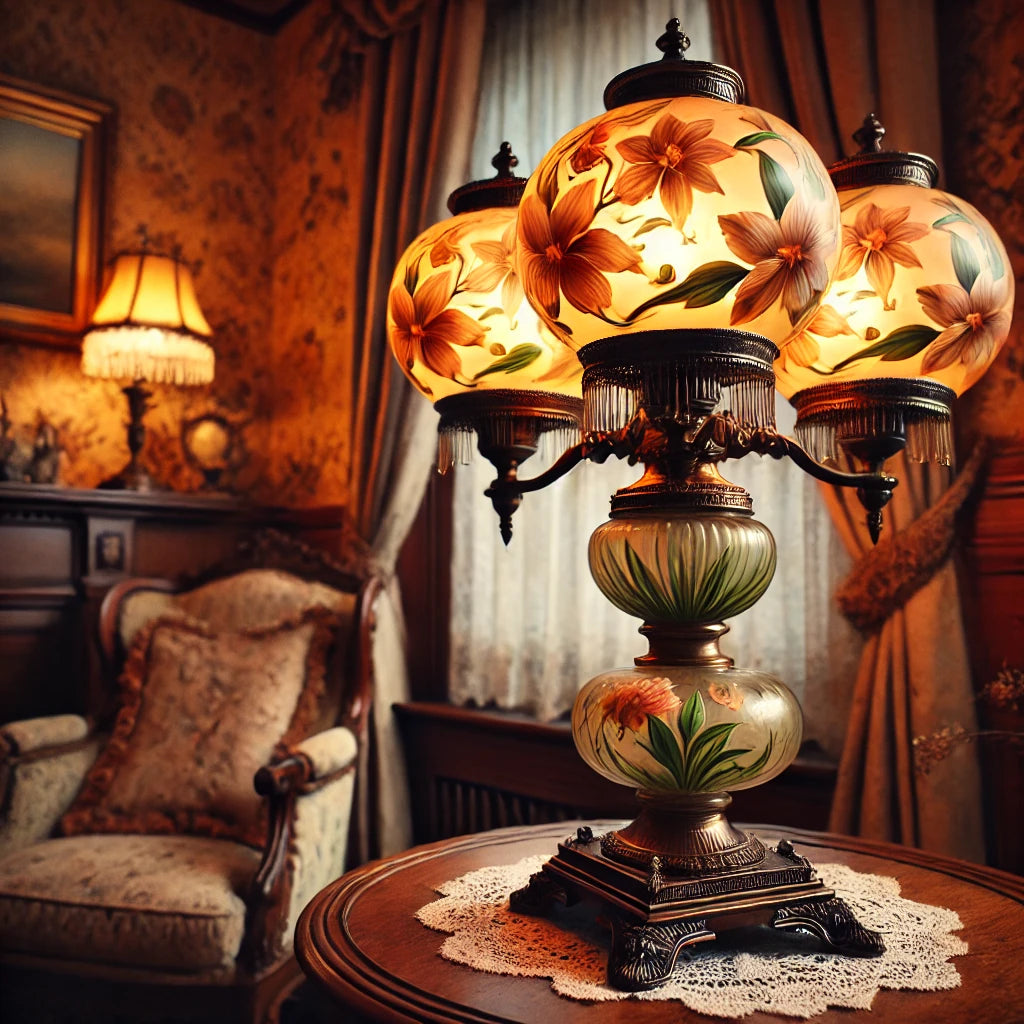Gone with the Wind lamps (GWTW) ,with their iconic hurricane-style shades and timeless beauty, are a favorite among collectors and lovers of vintage decor. These exquisite lamps evoke the charm of the Victorian and Edwardian eras, combining functionality with artistic craftsmanship. In this blog post, we’ll explore the history, characteristics, and tips for collecting and caring for these nostalgic treasures.
A Brief History of GWTW Lamps
Contrary to popular belief, GWTW lamps are not named after the 1939 movie Gone with the Wind. The term became widely used among collectors in the mid-20th century to describe the distinctive oil lamps of the late 19th century. These lamps were originally designed for both practicality and decoration, often adorning the parlors and dining rooms of Victorian homes.
During the late 1800s, advancements in glassmaking and kerosene technology allowed for the production of ornate and colorful lamps. Companies like Fostoria, Pittsburgh Lamp, and Consolidated Lamp & Glass Co. were known for their stunning designs. The advent of electricity eventually transformed these oil lamps into electric fixtures, though many enthusiasts still cherish the original kerosene versions.
Characteristics of GWTW Lamps
What makes a GWTW lamp instantly recognizable? Here are some key features:
-
Hurricane Shades: The hallmark of a GWTW lamp is its dual-globe design, consisting of a larger upper globe and a smaller lower one. These globes often feature hand-painted floral patterns, landscapes, or Victorian motifs.
-
Materials: GWTW lamps are typically made of glass and metal, with bases crafted from brass, bronze, or cast iron. The shades are often frosted, painted, or decorated with transfer designs.
-
Lighting Mechanism: Original GWTW lamps were kerosene-based, with a central burner and wick. Many have since been converted to electricity, but purists often seek out untouched oil-burning versions.
-
Artistry: The hand-painted designs are a significant part of their appeal. Each lamp is a testament to the artistry of the era, making them unique and highly collectible.
Tips for Collecting GWTW Lamps
If you’re interested in starting or expanding your collection, here are some tips to keep in mind:
1. Research and Learn
Understand the history and variations of GWTW lamps. Familiarize yourself with popular manufacturers, patterns, and styles to identify authentic pieces and avoid reproductions.
2. Condition Matters
Inspect the lamp for cracks, chips, or missing parts. Original, unaltered lamps are more valuable, but restored pieces can also be beautiful additions to your collection.
3. Look for Signatures
Some manufacturers marked their lamps with stamps or etchings, which can increase their value and desirability. Check the base or glass for maker’s marks.
4. Start Small
Begin with simpler, less expensive designs before investing in rare or elaborate pieces. This approach allows you to develop your eye for quality and authenticity.
5. Where to Buy
Antique shops, estate sales, auctions, and online marketplaces are great places to find GWTW lamps. Networking with other collectors can also lead to valuable discoveries.
Caring for Your GWTW Lamps
Proper care will ensure your lamps remain beautiful for generations to come. Follow these guidelines:
-
Gentle Cleaning: Use a soft, damp cloth to clean the glass and metal parts. Avoid harsh chemicals that could damage the paint or finish.
-
Handle with Care: Always lift the lamp by the base, not the globe, to prevent accidents.
-
Maintain Originality: If possible, preserve the original kerosene mechanism. If you choose to electrify an oil lamp, consult a professional to minimize alterations.
-
Proper Display: Keep the lamps in a stable, dust-free environment. Avoid direct sunlight, which can fade the paint and weaken the glass over time.
Decorating with GWTW Lamps
GWTW lamps can add a touch of vintage elegance to any space. Place one on a side table in your living room, or use a pair as bedside lamps for a cohesive look. Their warm glow and intricate designs create a cozy, inviting atmosphere that’s hard to replicate with modern lighting.
Final Thoughts
Gone with the Wind lamps are more than just lighting fixtures; they are pieces of history and artistry that bring a sense of nostalgia and charm to any home. Whether you’re a seasoned collector or a newcomer to the world of antiques, these lamps offer endless opportunities for appreciation and enjoyment.
Happy collecting!


